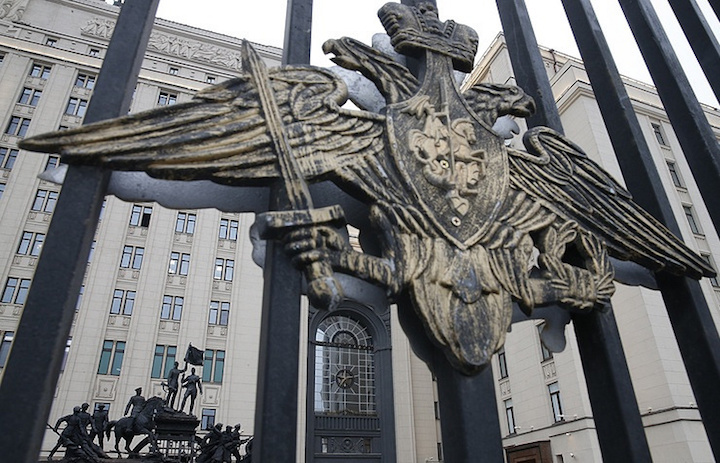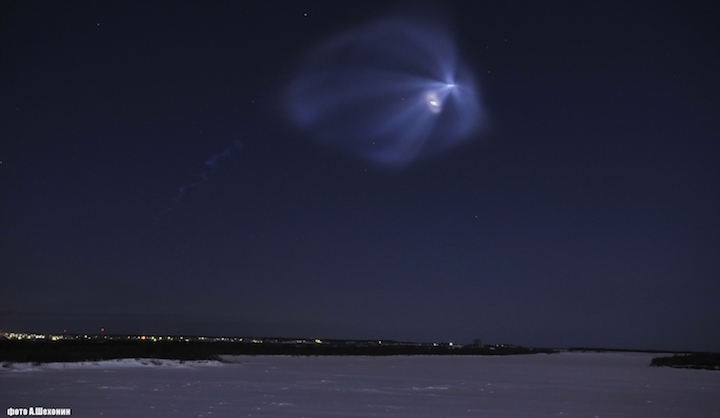30.03.2018
The satellite will serve the interests of the Defense Ministry
Russia's Aerospace Force has successfully launched the Soyuz-2.1V rocket from the Plesetsk space center in the northern Arkhangelsk region, the Defense Ministry said.
"A crew of the Space Troops of the Aerospace Force of the Russian Federation successfully launched the Soyuz-2.1V light launch vehicle at 20:38 Moscow Standard Time [17:38 UTC] that is carrying into space a satellite, which will serve the interests of the Defense Ministry," the report said.
Quelle: TASS
+++
Spectacular Soyuz 2-1v launch deploys Kosmos 2525

Russia’s Soyuz-2-1v rocket made its fourth flight Thursday, deploying the Kosmos 2525 satellite for the Russian military. The second of three orbital launches worldwide on Friday and six across a busy Easter period for spaceflight, Soyuz lifted off from the Plesetsk Cosmodrome at 20:38:42 Moscow Time (17:38 UTC).
Thursday’s launch saw a Soyuz-2-1v rocket place Kosmos 2525 into orbit for Russia’s military. Very little has been made public about this payload – even for a military satellite – other than unofficial reports that it was based around a new satellite bus developed by VNIIEM Corporation of Moscow.
The Eksperimentalny Maly Kosmichesky Apparat (EMKA) – or Experimental Small Spacecraft – is a platform developed by VNIIEM to support future miniature reconnaissance satellites.
The name Kosmos 2525 is a sequential designation under a system that is used for most of Russia’s military spacecraft. The Soviet Union began using numbered designations beginning with Kosmos – meaning “Space” or “Cosmos” – in 1962. Initially the name was used for any spacecraft in orbit that the Soviet Union did not want to identify publicly – including prototypes, satellites and planetary probes which had failed to reach their intended destinations and some scientific missions as well as military applications.
Kosmos 1, a technology demonstration mission launched under the Dnepropetrovsk Sputnik program, was deployed by a Kosmos-2I rocket in March 1962. Today, the designations almost exclusively used for military satellites – although one recent exception was Kosmos 2511 (also known as Kanopus-ST), a civilian scientific satellite that failed to separate from its carrier rocket.
Kosmos 2525 is reported to be carrying a remote sensing payload – likely an imager – as a demonstration and risk-reduction mission for the planned MKA-V series of imaging satellites. Writer Anatoly Zak has speculated that the satellite may be Zvezda, a demonstrator financed by VNIIEM and initiated in 2015 to pave the way for the MKA-V programme. If this is the case, then Kosmos 2525 likely has a mass of around 200 kilograms (440 lb) – similar to the proposed MKA-V.
The Soyuz-2-1v that launched Kosmos 2525 is the smallest version of Russia’s Soyuz rocket currently in service. Derived from the Soyuz-2-1b, it flies without the four boosters that make up Soyuz’ iconic first stage.

The core stage – the second stage of the Soyuz-2-1b – becomes Soyuz-2-1v’s first stage and is re-engined with an NK-33 in place of the RD-108A used on other versions of the rocket. The second stage of the Soyuz-2-1v is the third stage of the Soyuz-2-1b, powered by an RD-0124 engine.
The Soyuz-2-1b and 2-1v, along with the Soyuz-2-1a, make up the current generation of one of the longest-serving and most storied families of rockets. Soyuz traces its ancestry back to Sergei Korolev’s R-7 missile, which first flew in May 1957 becoming the world’s first intercontinental ballistic missile (ICBM).
Later the same year, a modified R-7 placed the first satellite – Sputnik 1 – into orbit. The R-7 also formed the basis of the Luna and Molniya rockets that carried early Soviet missions to the Moon and the planets and of the Vostok and Voskhod rockets that boosted early manned spaceflights including Yuri Gagarin’s Vostok 1 mission. Soyuz itself, an improved version of the Voskhod rocket, first flew in 1966 and has been upgraded several times since. The first Soyuz-2 rocket, a Soyuz-2-1a, made its maiden flight in November 2004.
Soyuz-2-1v first flew in December 2013 and has made two more launches since – in December 2015 and June 2017. The 2015 launch, which carried the Kanopus-ST oceanographic satellite, ended in failure as the payload was unable to separate from the rocket’s upper stage. All of other Soyuz-2-1v launches have been successful.
Depending on mission requirements, Soyuz-2-1v can fly as a two-stage rocket, or with an additional upper stage to make a three-stage vehicle. All of the rocket’s launches to date have used a Volga upper stage, which is derived from the propulsion system of the Yantar family of reconnaissance satellites. Volga, which is closely related to the Ikar upper stage used to launch Globalstar communications satellites aboard Soyuz-U rockets in the late 1990s, is powered by a 17D64 engine, burning unsymmetrical dimethylhydrazine propellant.

While it was not announced whether Thursday’s launch would use a two or a three-stage version of the rocket, Russia’s TASS news agency announced after the rocket had launched that it would take several hours for the satellite to reach its destination. This implied that the rocket did include the restartable Volga. However, this is now in question, per rocket observers on the NSF forum.
Russia’s next launch is scheduled for the middle of April, with a Proton-M/Briz-M rocket carrying the Blagovest No.12L communications satellite into orbit. The next Soyuz launch is planned for May, when a Soyuz-2-1b with a Fregat upper stage will deploy a Uragan-M satellite for Russia’s GLONASS navigation system.
Soyuz was the second rocket to fly to orbit Thursday, lifting off a few hours after India’s Geosynchronous Satellite Launch Vehicle (GSLV) carried out a flawless launch to place the GSAT-6A spacecraft into geostationary transfer orbit. A few minutes after Soyuz began its mission, China’s Chang Zheng 3B/G2 rocket – also known as the Long March 3B – launched from the Xichang Satellite Launch Centre with a pair of Beidou-3 navigation satellites. The three launches took place in the space of about six-and-a-half hours.
Earlier in the week it looked likely that Thursday would also see a fourth launch. However Iridium Communications – the customer for a SpaceX Falcon 9 launch – announced on Tuesday that their launch would be delayed to resolve an issue with one of the ten satellites aboard the rocket. This launch has since been rescheduled for Friday.
Quelle: NS
